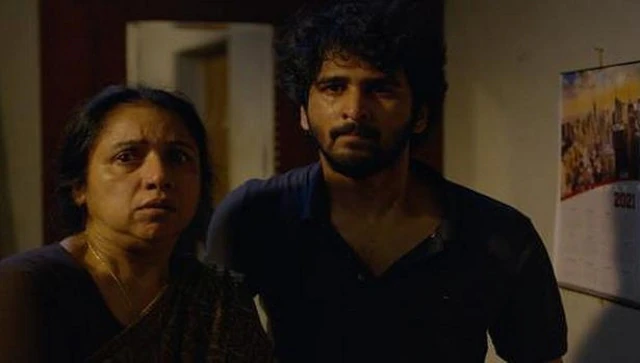MEDIA
Bhoothakaalam shows how horror doesn't always thrive in the secluded, but also amid social realities of the day
www.firstpost.com | March 6, 2022
Do horrors end with a change of address or moving to a new location and a new rented home? Social attitudes do not change overnight. They are a product of long sustained and deep social conditioning.
Bhoothakaalam, a new Malayalam film directed by Rahul Sadasivan, presents horror in a very intelligent way, breaking from the conventions of horror film as seen in Indian cinema.
It refrains from making definite claims and creates significant doubt through the film narrative. You often tend to think, especially towards the end of the film, if these events are happening for real or are the characters hallucinating? The characters in the film are also suffering from mental health issues. A significant part of the film revolves around mental health, a reality that is confronting us every day especially at a time when the pandemic continues to ravage both public and private lives.
Horror cinema often ends with proposing a solution or indicating an end of conflict. The end of Bhoothakaalam leaves one intrigued. It feels like a temporary respite for the characters in the film. After all, horror can be supernatural but it is also social and psychological.
These characters may have escaped the supernatural but can they really escape social and psychological horror – the horror of exclusion that family and neighbours subject them to?
Will that end with a change of address or moving to a new location and a new rented home? Social attitudes do not change overnight. They are a product of long sustained and deep social conditioning.
In many ways, Bhoothakaalam is a conventional mother-son story who are dealing with their own demons. They are far from being the myth of the perfect family. There is a lot of underlying tension between the duo who live in a rented house. The mother character, played by Revathy, is also grieving the recent death of her mother. She is seeking psychological help to deal with her emotional distress.
The son, played by Shane Nigam, feels trapped at home. In spite of a professional degree, he has been unsuccessfully hunting for a job but his hometown offers him no prospects. He even thinks of doing something else altogether to escape from home and its suffocating environs. The mother is, however, determined to not let the son leave because she cannot imagine living without him. She is also dealing with other issues at work owing to her mental health situation, and appears emotionally distant. Her colleagues and immediate supervisor find her strange and refuse to empathise with her situation. Family members also hold her responsible, a single mother for the upbringing of her son who has gone astray under her watch. She is never allowed to forget stories of his academic ingenuity. Social horror manifests in various ways all through the film, and its presence is overwhelmingly suffocating.
Horror films often look away from social situations as if the characters shown in these films live in perennial seclusion. Their lives are primarily showcased through their momentary interface with supernatural horror. But can horror be unidimensional? Even an otherwise well-made film like Tumbbad falls short in this aspect. It presents horror as a visual spectacle, and most of the conversation about the film revolves around the look of the film.
Bhoothakaalam, however, makes this transition successfully. Horror, in this case, also offers an opportunity to talk about many other issues highlighted in the film such as the mother-son dynamic, unemployed youth and their lifestyle, the son’s love life, and isolation of the urban middle class amongst others. Here, I must also mention the controlled performances by the leading actors defying the melodrama or exaggerated histrionics characteristic of horror films.
Comparisons with Hindi cinema are not warranted. There is very little in contemporary Hindi cinema that inspires cinematic excellence. Like other genres, it has also turned horror into a formula. Some of these films also feature a star actor who will hopefully help to hide its numerous shortcomings, such as the lack of a credible plot amongst other elements.
However, there have been a couple of Hindi films in recent times which have tried to reimagine the horror genre — Anvita Dutt’s Bulbbul and Amar Kaushik’s Stree immediately come to mind. Both films emphasise upon gender hierarchies and oppression. This in itself is a big departure considering the depiction of women in Hindi horror films, where women were either helpless or plain objects of desire. In these films, however, there is no denial of the supernatural whereas Bhoothakaalam turns the supernatural itself into a quandary, and asks if there is anything more horrifying than the struggles of everyday life?
The heightened access to Malayalam cinema [owing to its presence on various OTT platforms] amongst other film cultures further exposes the shortcomings of contemporary mainstream Hindi cinema, which thrives on formula-driven films or spew nationalism. A quick search of popular Hindi cinema of the last year reveals that films which have done well at the box office either feature a cop story or resurrect patriotism. Having said that, I also know that OTT is a small percentage of the nation’s audience. Nevertheless, it is a welcome change for the access it provides and opening new doors for Indian cinema viewership.
Bhoothakaalam is streaming on SonyLIV.
-Prof. Kunal Ray, Assistant Professor – English Literature.

